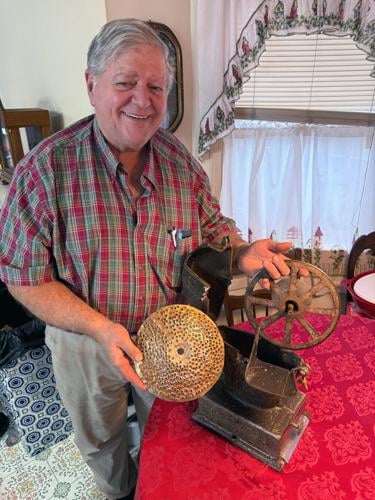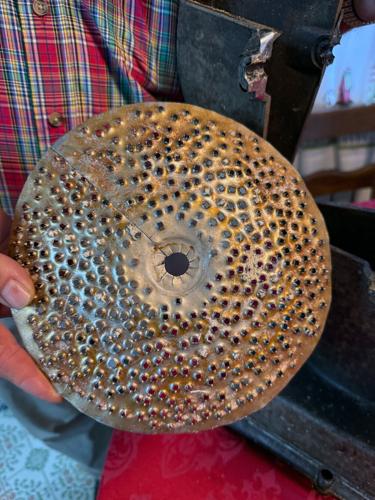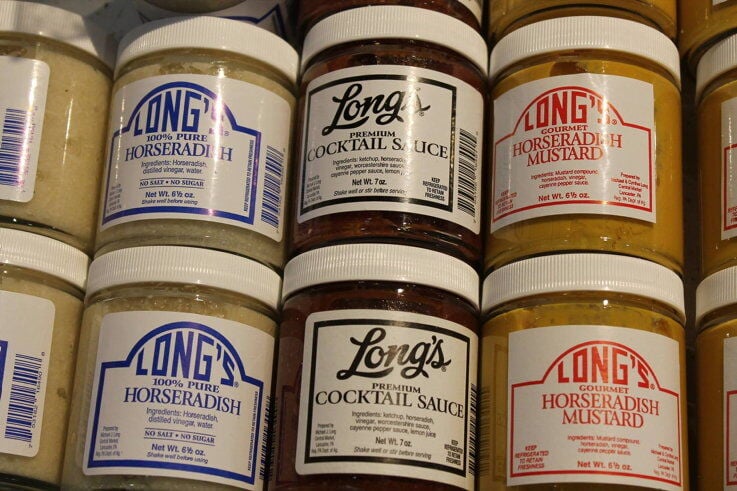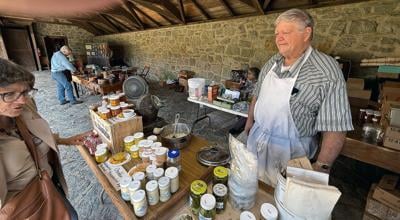For nearly 200 years, the name Long has been synonymous with horseradish in southeastern Pennsylvania.
Jeffrey Long, a fourth-generation horseradish maker in Lancaster County, said his great-great-grandfather, a German immigrant, was turning the tangy root vegetable into a cooking ingredient and condiment, starting in 1850.
Freshly ground horseradish has the most kick but, like a peeled potato, it will turn brown quickly, Long said.
“To preserve it, we mix it with distilled white vinegar, and it will hold its flavor and kick for three months when refrigerated,” he said.
His Uncle Frank inherited the company at the start of the 20th century and ground horseradish fresh from a pushcart in Philadelphia before Long’s dad Charles took over the business. He ground and mixed fresh horseradish for five decades at Lancaster Central Market and at Meadowbrook Farmers’ Market in Leola until the latter was destroyed in a 1997 fire.

Jeff Long with the cast iron grinder he uses to shred horseradish root.
Today, Long and his wife, Sue, use a simple cast-iron grinder almost identical to the ones used for decades by members of the Long family.
“We make horseradish in small batches by grinding the root into the consistency of Parmesan cheese and then mixing it with distilled white vinegar and water,” said Long, who learned the business from his dad.
The current location of Lancaster Central Market was established in 1889, and Long’s Horseradish is purportedly the second- oldest stand to set roots there.
When Jeff Long’s dad retired in 1999, the market stand was taken over by Jeff’s older brother Michael who ran the business for several years before retiring in 2019 and selling both the stand and the use of the Long name to a fellow Central Market stand holder.
Jeff Long, who is retired from a career as an electrician, had opened a second Long’s horseradish business in the 1980s with Sue and sold horseradish at Lancaster’s Southern Market for several years.

Jeff Long grinds fresh horseradish root with a fan blowing to keep the strong fumes away from his face at the 2024 Landis Valley Museum Fall Harvest Days.
Now, the Longs sell traditional horseradish and horseradish-related products at local events during the year, mainly in Lancaster County, with many at the Rough and Tumble Museum in Kinzers.
Long’s Horseradish products include traditional horseradish, horseradish mustard, honey horseradish, cheddar-bacon horseradish and Ghost Pepper Horseradish as well as horseradish pickles and jellies.
Freshly ground horseradish has the most kick but, like a peeled potato, it will turn brown quickly, Long said.
“To preserve it, we mix it with distilled white vinegar, and it will hold its flavor and kick for three months when refrigerated,” he said.
Horseradish has been used for centuries for both healing and culinary purposes. The Egyptians used the root plant as medicine, while the Greeks and Romans used it as a rub for body pain and menstrual cramps.
It’s also one of the five bitter herbs that people of the Jewish faith eat at their Passover celebration.
Horseradish is part of the mustard family and is the long, large root of a horseradish plant, which grows from early spring to late fall.

Jeff Long uses this circular metal grater to turn horseradish root into flakes.
The vegetable was first used as early as the 1600s to add flavor to soups and as a condiment, and became fashionable to eat with beef and oysters at the same time in England.
It arrived in Colonial America with German immigrants in the 1700s and was used for cooking as well as medicinal purposes including cough syrup. It remains popular in southeastern Pennsylvania where many residents with German heritage were introduced to it by their parents as children.
The horseradish root has no aroma but it is characterized by its strong, pungent taste and a new, younger Generation Z loves its kick as they have embraced other hot sauces including those made with Ghost, habanero, chili and jalapeno peppers.
Horseradish as a condiment can be used with just about anything, Long said, and it finds its way regularly into cocktail sauce, or to accent beef, pork or even eggs.
Finding the right firm, white, large horseradish roots isn’t easy even here in Lancaster Country, Long notes, where just about any produce is sold at local farm markets and produce auctions. “For the roots to grow large enough to grind,” he says, “they need a soft soil throughout the growing season and that isn’t the case in Lancaster County.”

Long’s long-time supplier has been Sam Stoltzfus from Gordonville, Pennsylvania, who did grow the plant for years on his farm as a replacement crop for tobacco. He now imports horseradish roots from Illinois to keep his customers supplied.
“Although the horseradish root has no aroma, when flaked and used as a spice in cooking or when preserved as a condiment, its tanginess and heat trigger the pain receptors in our mouth immediately. The ‘heat,’” he continues, “can be toned down as many people do in cocktail sauce by mixing just small portions with ketchup or chili sauce.”
Although horseradish is grown in many parts of the United States, some 60% of the world’s supply comes from southwestern Illinois, whose soil, rich in potash, a nutrient important to its growth, allows the root vegetable to grow as long as 18 inches. It can expand deep into the earth because of the area’s ideal soft growing soil.







